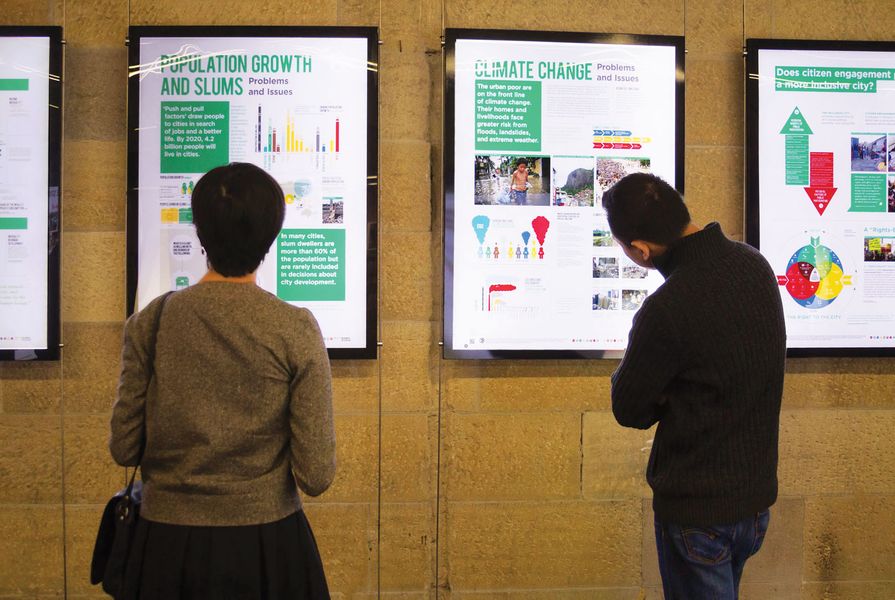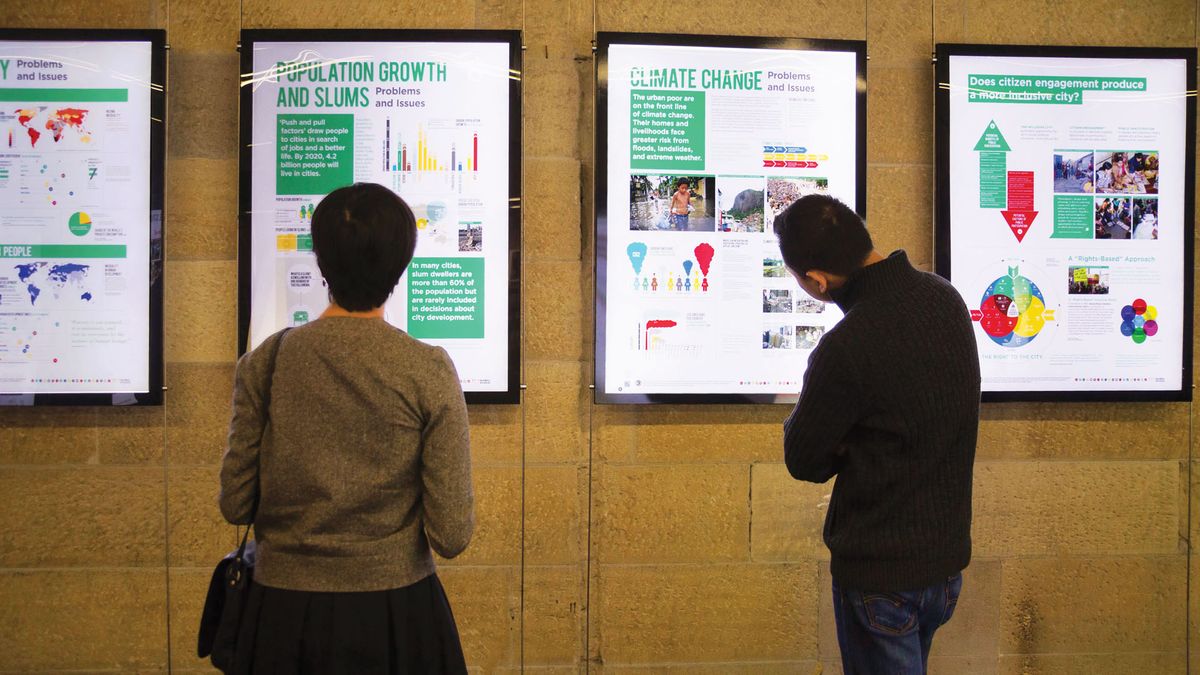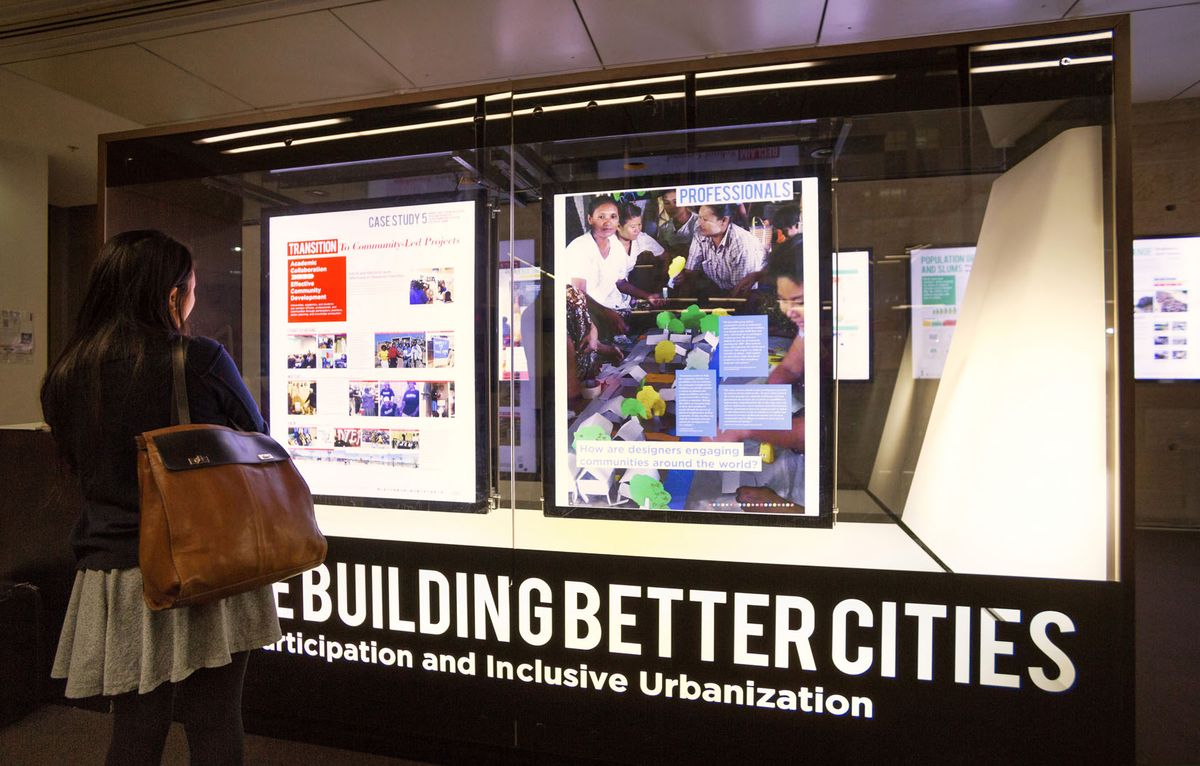Over the past decade there has been a resurgent movement within architecture, and particularly architectural education, to understand and engage in finding solutions for the more than one billion people living in slums. The discipline of architecture, with its creative, problem solving approach, skill in mediating competing interests and ability to articulate possible futures, is well placed to contribute. Some approaches have failed, treating the situation as a distant object of study and variously fetishizing the slum as an aesthetic device or producing highly technical urban solutions of dubious appropriateness or use to the people themselves.
The People Building Better Cities travelling exhibition, held at Customs House from 12 April to 19 May, brings together a selection of work that moves beyond these outmoded approaches by partnering architects with local communities, forming innovative teams combining the best of local and outsider knowledge.
A significant portion of the exhibition details the work of Global Studio, an annual, travelling design studio initiated by Adjunct Professor Anna Rubbo at the University of Sydney in 2005, which brings together an international group of students to work with marginalized communities on ideas for their city.
Global Studio overturns the old model of “developing” countries having all the problems and “developed” countries having the solutions. Students and mentors are equally represented across the GDP divide, while the cities chosen for engagement are also a rich mix. A student from Kenya might propose a night market for a run-down Vancouver street one year and a student from Belgium might propose an insulation strategy for a Johannesburg township the next.
It is clear from the cases presented that participants are encouraged to think beyond architecture in its traditional sense. The most recent studio in Bhopal, India, deployed a wide range of both processes and outputs. These ranged in scale from the city – with intricate mappings of existing neighbourhoods, proposals for cantilevered pedestrian bridges and incremental housing development – to the personal, with the creation of a prototype backpack that doubles as a seat or writing desk to assist children’s posture.
The modus operandi of Global Studio has, for the most part, been a kind of “idea carpet bombing,” producing plentiful proposals to both highlight certain situations and provide avenues for change if any local actors wish to take them on. The inherent danger of this approach is that, without strong local support, the ideas remain as purely paper architecture.
The potential of the Global Studio model to make real change is evident in the case of Johannesburg, where Global Studio formed a strong partnership with the community of Diepsloot over three consecutive years, resulting in the establishment of two long-term projects. WASSUP (Water Amenities Sanitation Services Upgrading Program) grew from a Global Studio student project, mapping defective communal toilets and drains in the township, into a self-managed community repair enterprise. The Diepsloot Arts and Culture Network (DACN) was formed to unlock the potential of the huge wealth of creative talent in Diepsloot and has since curated festivals, exhibitions and public art commissions.
The work of another group showcased in the exhibition demonstrates even more clearly the massive advantages of working in close partnership with the people affected. The Asian Coalition for Community Action (ACCA) channels funds from donors directly to communities to implement their own solutions to the problems facing them. Communities receive seed funding for projects ranging from new pathways to entire housing developments, all managed and delivered by the communities themselves. The communities are joined by members of the Community Architects Network (CAN) to map their situation and articulate their plans for change. By taking full advantage of community knowledge, skills and resources, the ACCA projects are not only more appropriate to the actual needs of the community, they are cheaper and implemented more quickly than projects delivered by outside agencies.
The crucial importance of establishing such strong participation from communities themselves raises the question of how such participation can be fostered. Any community is a complex entity to work with and for those with long histories of exclusion and exploitation, it is particularly hard to place much faith in an outsider promising rosy visions of solving their problems with a 3-D perspective.
For Khondaker Hasibul Kabir, a professor in the Department of Architecture at BRAC University in Bangladesh whose work is also featured in the exhibition, the methods for building trust require just as much critical reflection as the methods for building houses. Kabir and his students spent a year living with a coastal community following the destruction of their village by cyclone. The relationship built between the students and the villagers resulted in an ingeniously simple raised concrete platform that could act both as a refuge in time of disaster and as a solid frame to build a customized house. The project, which consisted of forty-three disaster-resilient homes, was funded by the UN for the cost of a single traditional emergency shelter.
Building trust is also central to the work of Australian group Healthabitat, who take Fred Hollows’ credo of “no survey without service” and apply it to addressing the chronic failure of housing to provide positive health outcomes. Working with marginalized communities from rural Nepal to remote Australia and urban New York, Healthabitat takes the approach that providing immediate solutions to people’s environmental problems (by fixing their tap or the light in the toilet) is crucial to developing the trust required to make larger-scale changes.
The PBBC team, led by Anna Rubbo, includes Megan Bullock and Matthias Neumann in New York, Devangi Ramakrishan in Pondicherry, Jennifer van den Bussche in Johannesburg and William Chan in Sydney. PBCC is supported by a Sappi North America “Ideas that Matter” grant. It has been translated into Portuguese, French, Spanish, Hindi and Chinese. The PBBC exhibition, in keeping with its global charter, has also been held in Bangkok, Rio de Janeiro and Johannesburg, with plans in place to take it to cities in India, China, the USA, Colombia, Egypt, Ghana, Cameroon, Mozambique and Kenya over the next twelve months.
In each new site the exhibition acts as a catalyst for public programs connecting to relevant local issues. In Sydney a panel discussion, on public participation in city making, cracked open the issues raised by the NSW Government’s white paper outlining the restructuring of community input in planning matters.
The central questions asked by the exhibition are as relevant in Sydney as in any other location: Can our processes be more democratic? Can our city be better?
The People Building Better Cities travelling exhibition was in Sydney from 12 April to 19 May 2013 at Customs House.

















